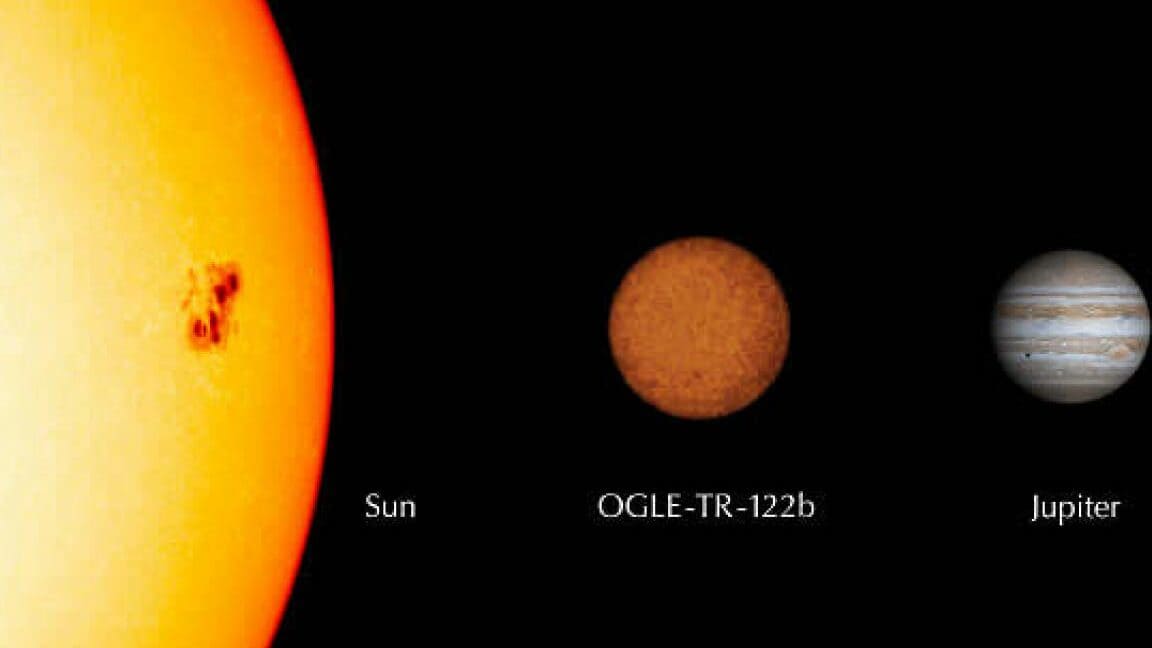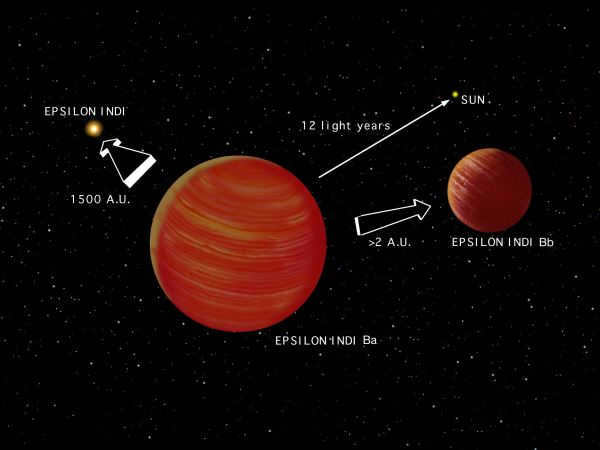
- Mass (in solar masses): 0.045
- Type: Brown dwarf
- Distance: 11.83 sv years
- Constellation: Indian
- Age: 1.3 billion years old
- Year of discovery: 2003
Epsilon Indian is among the nearest stars to our solar system. It is visible from Earth as a moderately bright star. The brightest star in Epsilon Indian’s sky is Canopus, followed by Sirius. The constellations seen from Epsilon Indian are similar to those visible from Earth. Epsilon Indian has a main star called Erzaba, which is orbited by a pair of brown dwarfs named Epsilon Indian BA and BB. These dwarfs cannot be seen with the naked eye from their planets. Epsilon Indian BA is currently ranked as the tenth smallest star.
9 Teide 1.
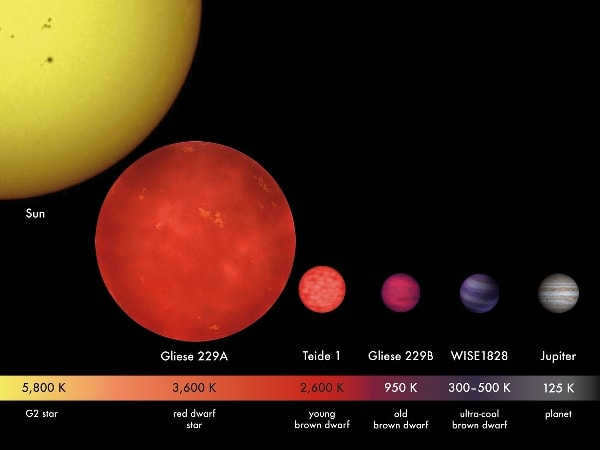
- Mass (in solar masses): 0.041
- Type: Brown dwarf
- Distance: 400 light years away
- Constellation: Taurus
- Age: 120 million years old
- Year of discovery: 1995
8 HD 98230B.
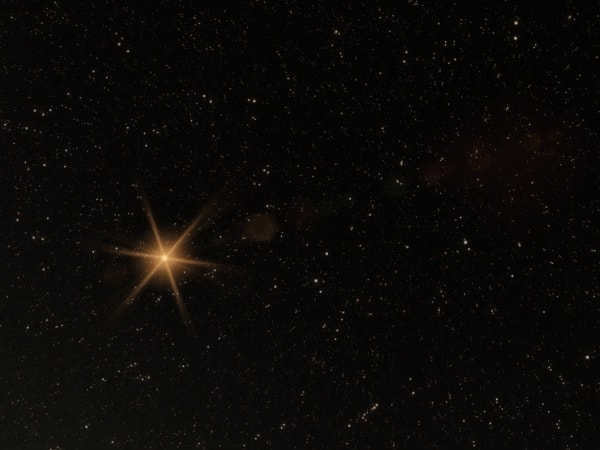
- Mass (in solar masses): 0.037
- Type: Brown dwarf
- Distance: 27.4 light years.
- Constellation: Ursa Major
- Age: 6 billion years
HD 98230 is a binary star system consisting of two stars that are gravitationally bound to each other. One of the stars in this system has a mass equivalent to that of 43 Jupiters.
7 Epsilon Indian BB.
The 7 Epsilon Indian BB.
Indian BB at 7 Epsilon.
The Indian BB located at 7 Epsilon.
7 Epsilon’s Indian BB.
The Indian BB at 7 Epsilon Street.

- Mass (in solar masses): 0.024
- Type: Brown dwarf
- Distance: 11.83 light years
- Constellation: Indian
- Age: 1.3 billion years old
- Year of discovery: 2003
Epsilon Indian is one of the closest stars to the Solar System. It appears as a moderately bright star from the vicinity of the Sun. Canopus is the brightest star in the sky of Epsilon Indian, followed by Sirius. The shapes of most constellations are similar to those visible from Earth. Epsilon Indian has a pair of brown dwarfs (Epsilon Indian BA and BB) orbiting around its main star, which are not visible to the naked eye from its planets. Currently, one of these dwarfs is ranked as the seventh smallest star.
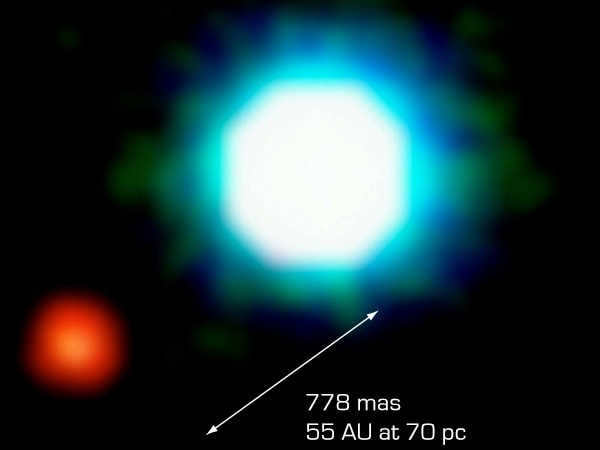
- Mass (in solar masses): 0.021
- Type: Brown dwarf
- Distance: 173 light years away
- Constellation: Hydra
- Age: 8 million years old
- Year of discovery: 2001
2M1207, situated in the Hydra constellation, is a brown dwarf that has an exoplanet in its orbit. In April 2004, a team of astronomers from Europe and America made the discovery of a faint object near the young brown dwarf 2M1207. By analyzing the infrared spectrum, which showed the presence of water molecules, the object was estimated to have a mass of 4 Jupiter masses, falling below the threshold for deuterium burning that distinguishes planets from brown dwarfs. Considering the mass ratio of the components (1:5), it is improbable that the planet formed from a protoplanetary disk (remnants of which were found in both 2M1207 and later in 2M1207 b). Instead, it is believed that the system formed as a double star with very low mass. There is a possibility that 2M1207 b’s classification will be changed from a planet to a “planeto” in the near future.
5 Gliese 229B: The Enigmatic Dwarf Star
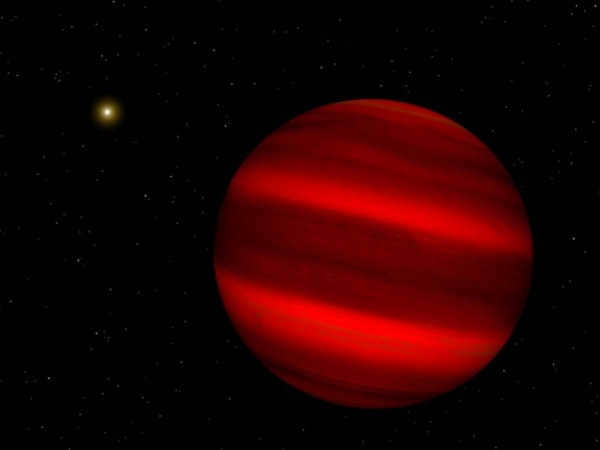
- Mass: 0.021 solar masses
- Type: Brown dwarf
- Distance: 18.8 light years
- Constellation: Hare
- Age: 3 billion years
- Year of discovery: 1994
The Gliese 229A star has a companion, known as Gliese 229B, which is a brown dwarf. In October 1994, astronomers made the discovery of a brown dwarf in the Gliese 229 system. Later, this discovery was visually confirmed using the Hubble orbiting telescope. Gliese 229B is estimated to be 25-65 times more massive than Jupiter, with a surface temperature of approximately 1000-1200 °C. The atmosphere of this object is abundant in methane. Gliese 229B orbits at a distance of about 39 astronomical units from its parent star, which is almost the same average distance that the dwarf planet Pluto orbits the Sun.
4 Serpentine 1622A, rephrased.
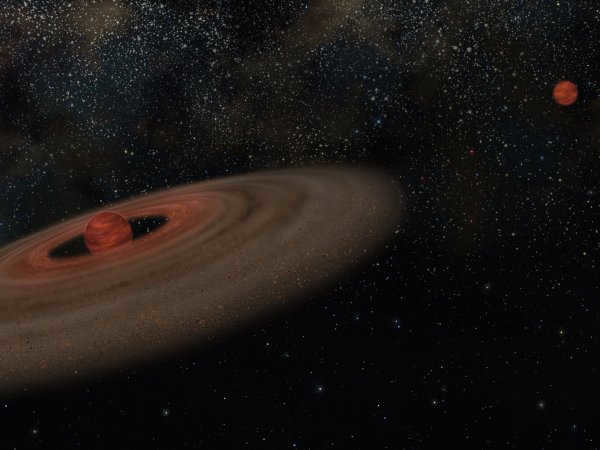
- Mass (in solar masses): 0.016
- Type: Brown dwarf
- Distance: 400 light years
- Constellation: Serpentine
- Age: 5 million years old
- Year of discovery: 2006
A binary system composed of two brown dwarfs that revolve around a shared center of mass. Both brown dwarfs are situated in the Serpentine constellation and are located 400 light years away from Earth. The precise mass of the pair is unknown, but it is likely greater than 13 times the mass of Jupiter. The age of the binary system is estimated to be 5 million years.
3 Serpentine 1622B: A Unique Paraphrase with HTML Markup
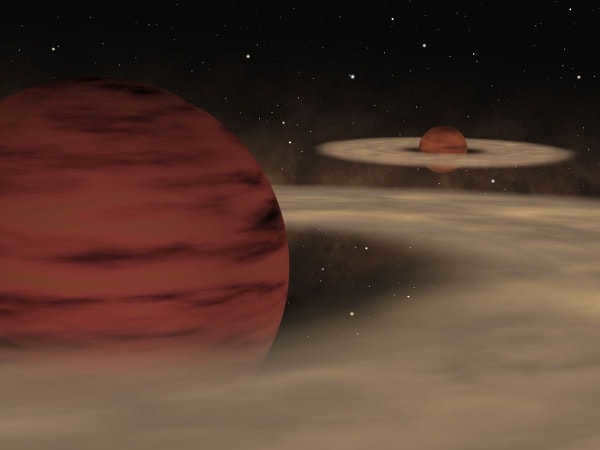
- Mass (in solar masses): 0.014
- Type: Brown dwarf
- Distance: 400 light years away
- Constellation: Serpens
- Age: 5 million years
- Year of discovery: 2006
The discovery of the brown dwarf system presented a challenge to the prevailing theory that free-floating planets could be captured by other stellar systems. The gravitational bond between such a planet and its star would be incredibly weak and susceptible to disruption from even the slightest disturbance.
2 OTS 44.
Rephrase the text, making it unique, using the English language and preserving the HTML markup:
2 OTS 44.
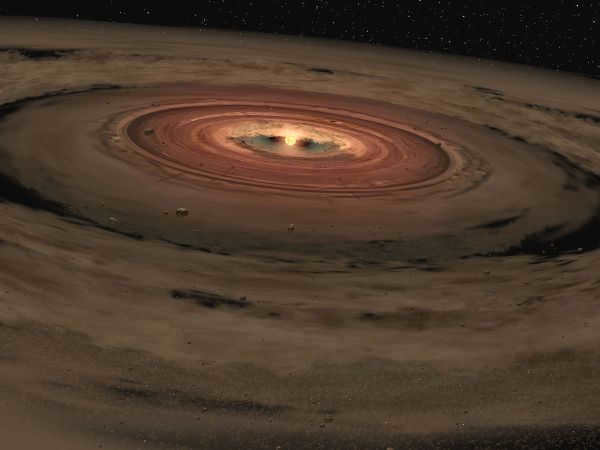
- Mass (in solar masses): 0.013
- Type: Brown dwarf
- Distance: 554 light years.
- Constellation: Chameleon
- Age: 2 million years old
- Year of discovery: 1998
1 Cha 110913-773444
can be paraphrased as
1 Cha 110913-773444 is an example of unique identification.
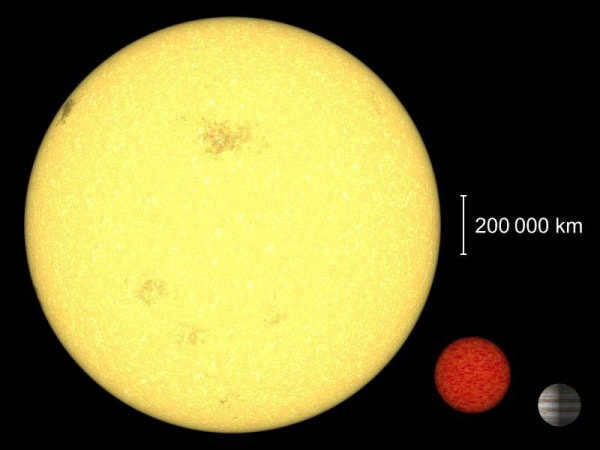
- Mass: 0.008 solar masses
- Type: Brown dwarf
- Distance: 500 light-years
- Constellation: Chameleon
- Age: 2 million years
- Year of discovery: 2005
Cha 110913-773444 is an astronomical object located in the Chameleon constellation and surrounded by a protoplanetary disk. It is situated 500 light-years away from Earth, making it a fascinating representation of an emerging planetary system. Notably, it is currently recognized as the smallest system of its kind, measuring 100 times smaller than our own solar system. However, there is no unanimous agreement within the scientific community regarding the classification of the central object within this system. Some experts debate whether it should be considered a sub-brown dwarf or an orphan planet.
The discovery of Cha 110913-773444 was made by a team of scientists led by Kevin Lachman from the University of Pennsylvania. The researchers utilized the powerful Spitzer and Hubble space telescopes, along with two ground-based telescopes situated in the Chilean Andes, in order to observe and study this intriguing astronomical object.
Approximately 2 million years old, Cha 110913-773444 possesses a mass approximately 8 times that of Jupiter.
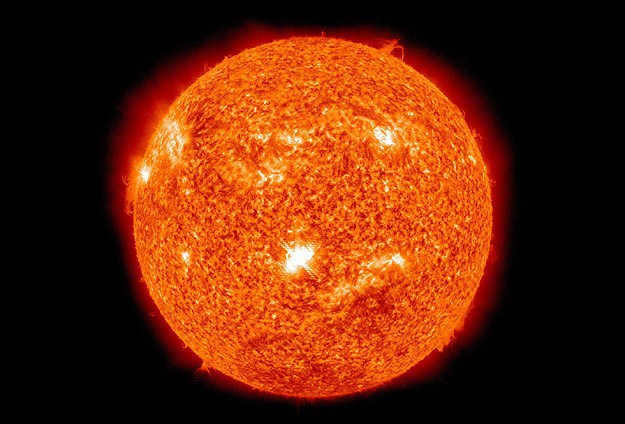
According to astronomers, in approximately 3-4 billion years, our Sun, which is our home star, will start to deplete its hydrogen reserves. The thermonuclear reaction that relies on hydrogen will no longer be able to counteract the gravitational compression. As the core of the star shrinks significantly, the pressure and temperature will reach levels that will allow for the second stage of stellar evolution – the synthesis of carbon from helium. At this point, the Sun will expand its diameter from the current 1.4 million kilometers to 355 million kilometers, ultimately engulfing our Earth. Our planet will then burn and vaporize in the scorching atmosphere of the newly formed red giant.
Dwarf stars in the vastness of space: exploring their potential
Resources on the subject

Our celestial body is classified as a yellow dwarf star. Yellow dwarfs are stars that have a mass that enables them to sustain the conditions required for the thermonuclear fusion of helium from various types of hydrogen, including regular, light hydrogen. The mass range of this type of celestial objects is between 0.81 and 1.22 times the mass of the sun, and their surface temperature is heated to around 5,000-6,000 Kelvin (the same scale as Celsius, where zero Kelvin is equivalent to -273 ° C, or absolute zero).
Objects that are born with less than 8% of the solar mass are generally not meant to become stars in the traditional sense. They serve as a sort of bridge between giant planets and stars. Their mass only allows for the burning of heavy isotopes of hydrogen – deuterium and tritium – in their interiors. The surface temperature of these “non-stars” can sometimes be no more than a thousand Kelvin. According to the majority of scientists, these stars will resemble our Jupiter, with equatorially oriented cloud bands that are illuminated by a reddish-brown light from within.
However, among the category of stars that our Sun is a part of and brown dwarfs, there exists a particularly fascinating type of celestial objects – red dwarfs. While the pressure and temperature within their cores are sufficient to sustain conditions for a complete thermonuclear fusion, it occurs at an incredibly sluggish rate. Within this group lies the tiniest known star in the Universe as of now, which goes by the name OGLE-TR-122b.
OGLE-TR-122b was detected thanks to the efforts of scientists searching for the enigmatic and elusive substance known as dark matter. The challenge lies in locating an entity situated hundreds or even thousands of light-years away from our planet, which emits no detectable radiation. To overcome this obstacle, the Polish-American initiative OGLE (named after the objects it has discovered) devised a method based on the gravitational impact that such an entity would exert on the light reaching us from more distant stars or galaxies. Thanks to cutting-edge scientific technology, we are now equipped to identify even the slightest deviation caused by these celestial entities.
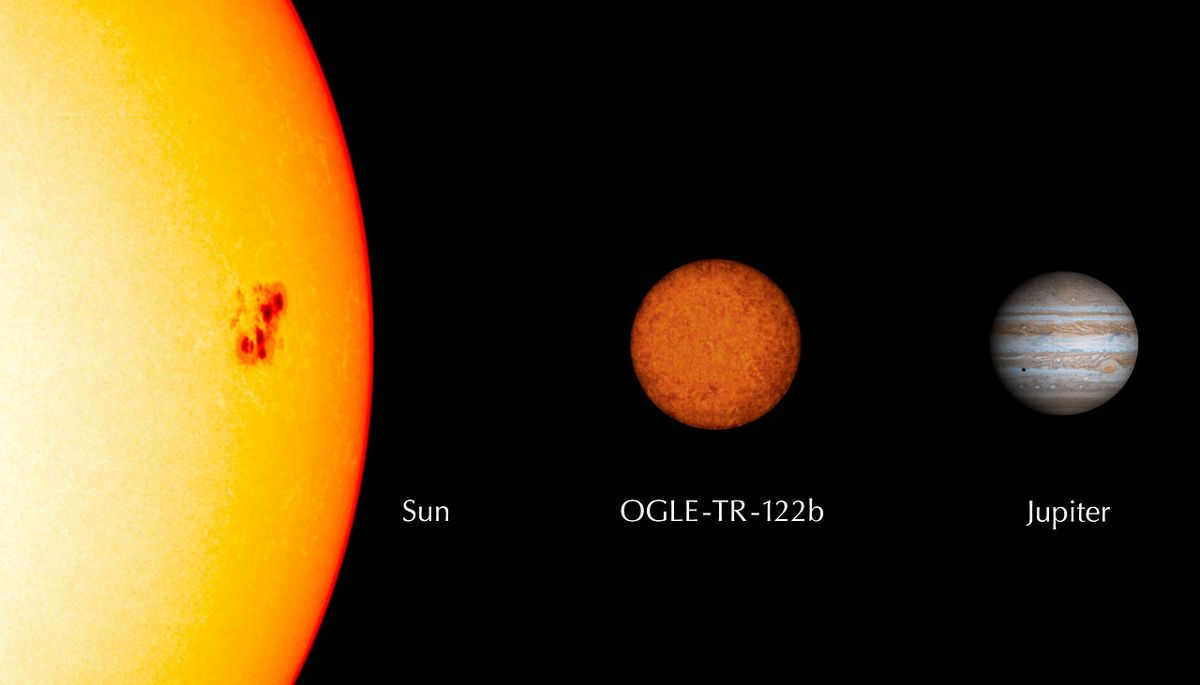
OGLE-TR-122b holds the record for being the tiniest star ever found.
An unintended consequence of the program was the identification of numerous objects, such as brown or red dwarfs, which are not visible from Earth due to their small mass and extremely low brightness. Additionally, in 2005, the discovery of the smallest star in the Universe, known as the red dwarf OGLE-TR-122b, was made. This star is part of a binary system, with its larger neighbor OGLE-TR-122a being similar in mass to our Sun. However, OGLE-TR-122b, often referred to as the “little brother,” is a prime example of a red dwarf. With a diameter of only about 160 thousand kilometers, one could argue that it is quite small, although it is worth noting that our Jupiter is not much larger at 140 thousand kilometers. OGLE-TR-122b has a mass of approximately one hundred times that of Jupiter or 9% of the Sun’s mass. Despite its small size, the smallest star in the Universe is actually 50 times denser than our own star.
Red dwarf stars are incredibly unique. Their most notable characteristic is their remarkably long lifespan. Around 4.5 billion years ago, when our solar system was still a swirling mass of dust and gas, red dwarfs had already formed and were hosting planets. Our own star, the sun, will eventually transform into a red giant, encompassing Mercury, Venus, and Earth in its fiery embrace in approximately 5 billion years. After that, in about 7…8 billion years, the star will evolve into a white dwarf, a burnt-out remnant, while red dwarfs will continue to radiate for billions of years (and potentially even up to a trillion years, as some hypotheses suggest) without aging significantly….
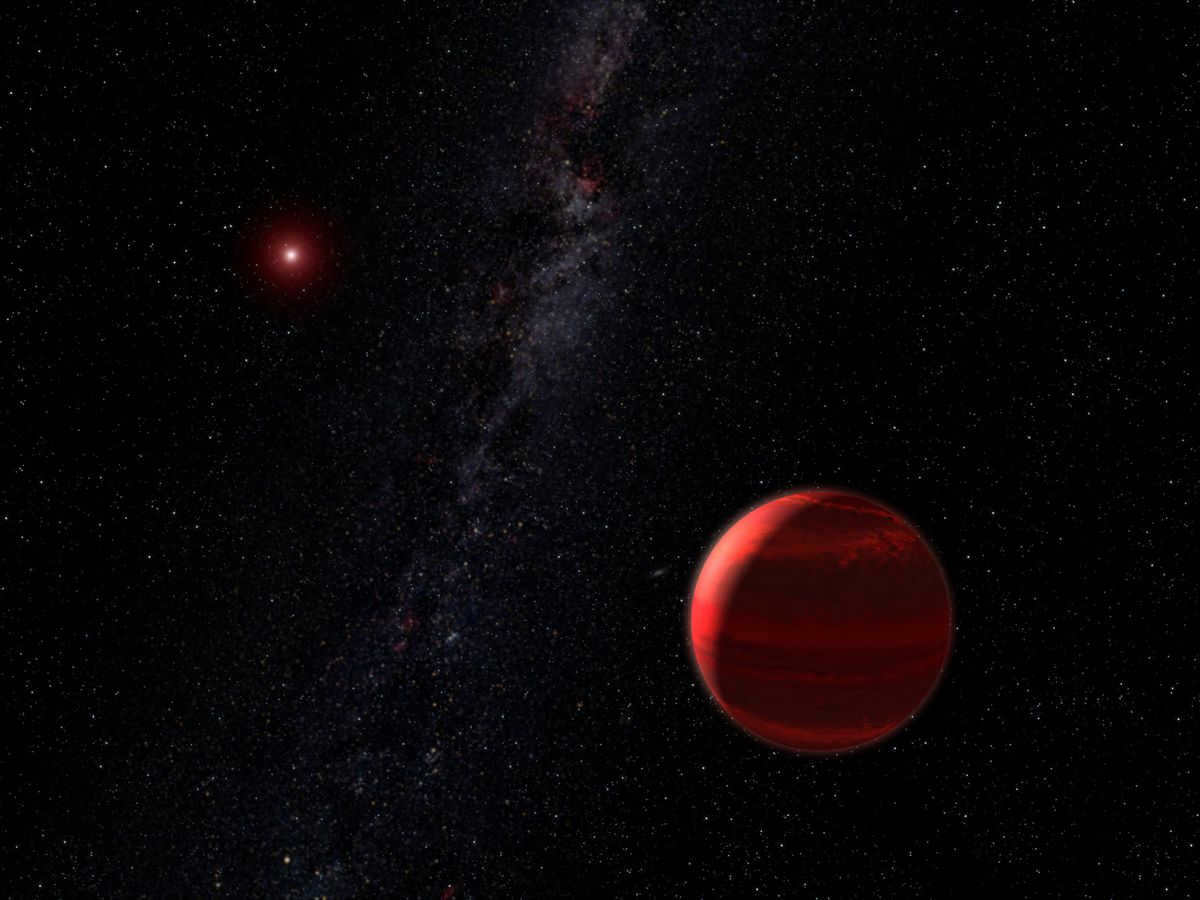
The longevity of a star like this creates ideal conditions for the emergence and evolution of life on its planets. Imagine, billions and billions of years with stable and unchanging weather conditions on the planet. Most astrobiologists believe that the planets and moons orbiting red dwarfs are the most likely places to find extraterrestrial life.
Another fascinating fact about red dwarfs is their abundance. If we could see all these celestial bodies with the naked eye, just like we see brighter stars, the night sky would be five times brighter. Despite the challenges in detecting red dwarfs, they are estimated to make up about 80% of the total stellar mass in the universe.
How to View
Regrettably, it will not be feasible to observe the system (a-b) OGLE-TR-122. The brightness of this pair is approximately 16 star magnitudes (keep in mind that the human eye can only perceive stars up to magnitude 6). However, the primary challenge for conducting observations is that OGLE-TR-122 is situated in the southern hemisphere, making Australia, for example, the optimal location for such observations.
The coordinates provided are intended for amateur astronomers who are willing to travel there and possess high-quality optics capable of azimuth pointing:
Enjoy your observation!
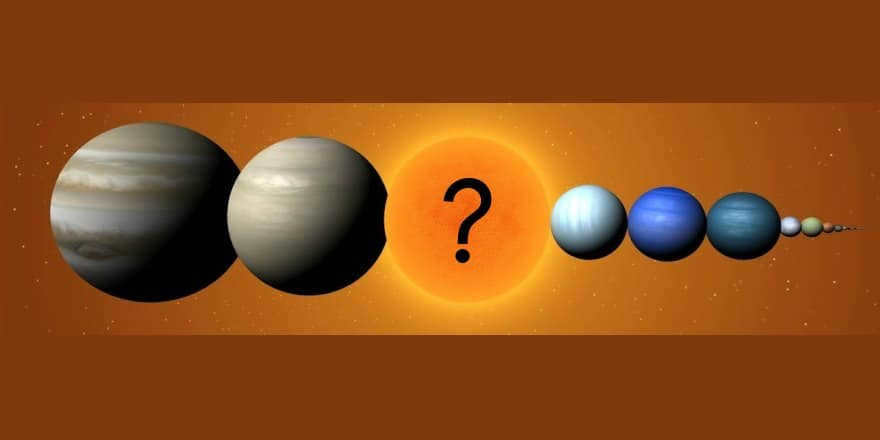
We have already encountered the most massive celestial body (“The biggest star in the Universe is destined for a swift demise.“). Now, let’s take a look at the appearance of the tiniest star in the Universe.
Previous applicants
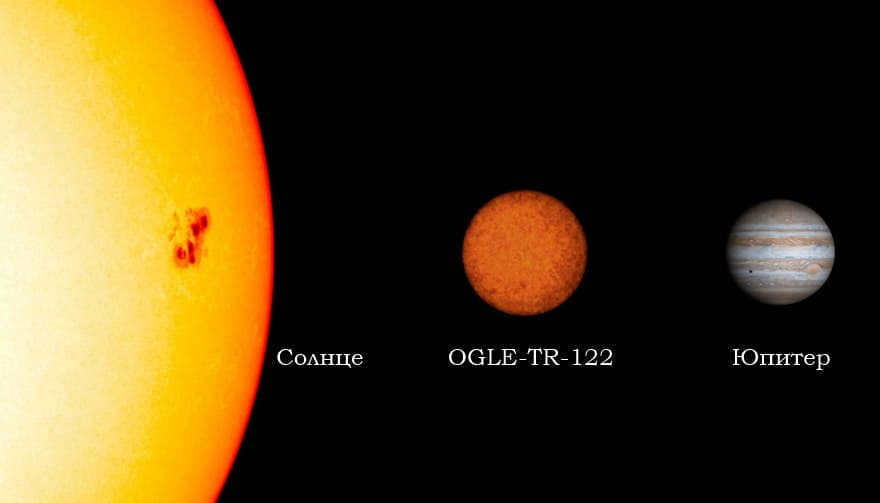
The size comparison of OGLE-TR-122
Often, small stars are born in regions with limited hydrogen content. A celestial object must possess a nuclear fusion process to be considered stellar. To meet this criterion, the object must contain at least 7.5% of the solar mass (theoretically).
Previously known as the smallest star in the Universe, OGLE-TR-122 is situated in the Kiel constellation. It is a binary star system, with one component belonging to the main-sequence category. The pair was initially observed in 2005. The orbital period around the center of mass amounts to 7.3 days.
One of the stars bears a striking resemblance to a star within our own solar system. However, the second star (OGLE-TR-122 B) is classified as a red dwarf. Its radius measures 0.12 times that of the Sun. Comparatively, it is only 16% larger than Jupiter, the gas giant. In essence, it is nearing the lower mass threshold.
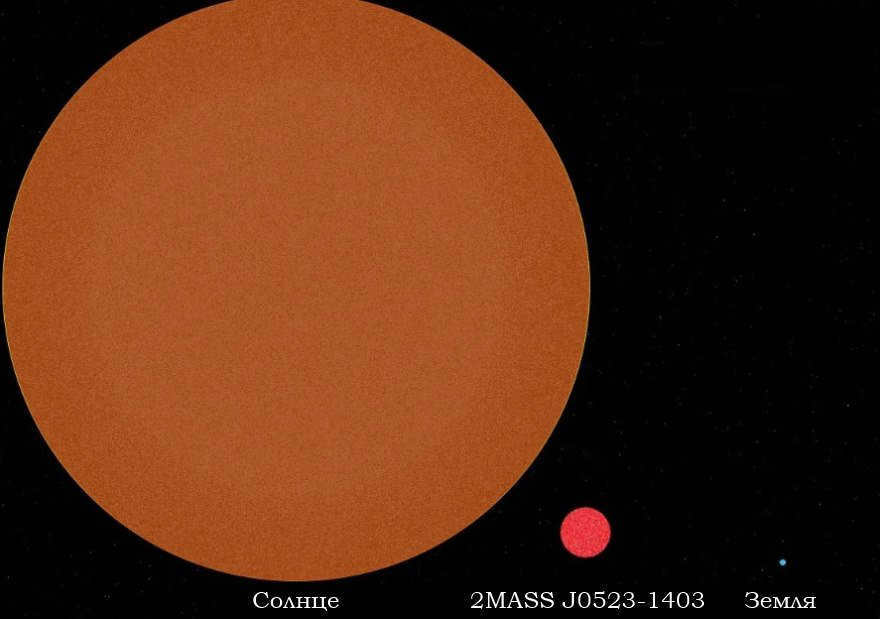
The size comparison of 2MASS J0523-1403
Another small red dwarf, known as 2MASS J0523-1403, has recently been identified as a potential candidate. This celestial object is located in the Hare constellation and is approximately 40 light years away from Earth. It has an effective temperature of 2074 K.
With a radius measuring only 0.086 times that of the Sun and a mass less than 0.08 times that of the Sun, 2MASS J0523-1403 is on the verge of being classified as a brown dwarf. Stellar parameters suggest that objects with a mass between 0.012 and 0.07 solar masses may no longer sustain thermonuclear reactions and begin to cool down.
The tiniest star
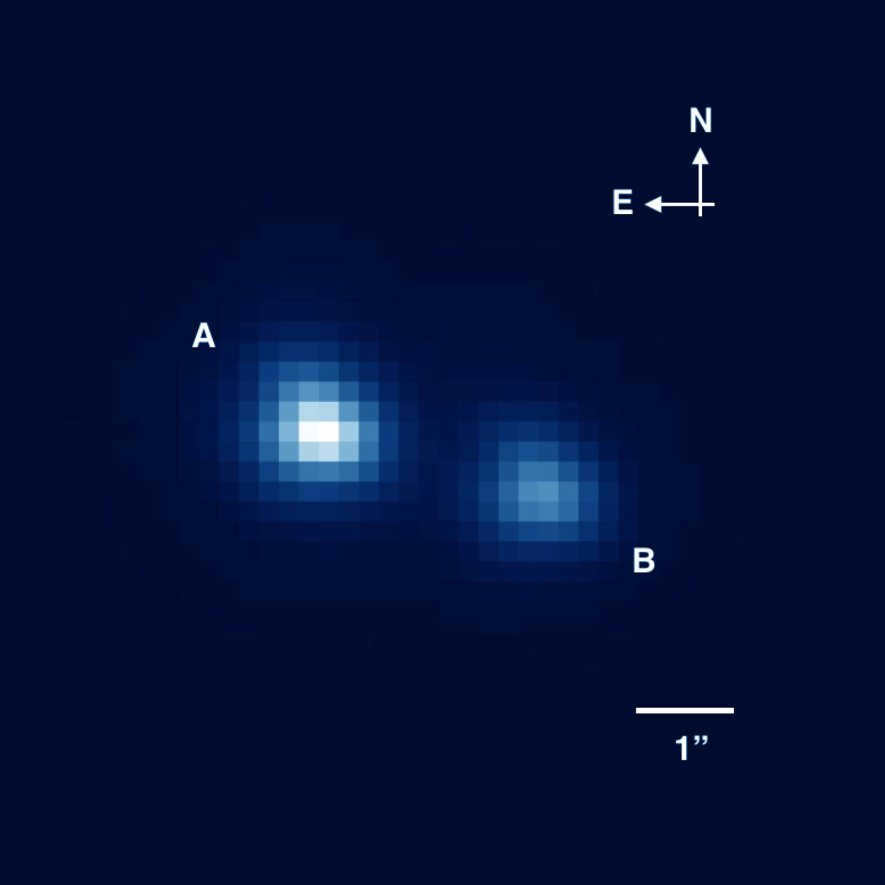

An impressive image of the EBLM J0555-57 double star system captured by the Swiss 1.2-meter Leonhard Euler telescope at ESO’s La Silla Observatory
As of 2017, the EBLM J0555-57 holds the title of the smallest star in the universe. Positioned in the constellation Painter, this triple star system is situated 600 light years away from our solar system. One of the stars is approaching the theoretical stellar limit.
P.S.
Therefore, up until now, EBLM J0555-57 C holds the title as the tiniest star ever found. Nevertheless, scientists are constantly exploring and analyzing the hypothetical threshold at which a star can still sustain nuclear fusion. It is possible that a fresh contender will be unearthed in the near future.

Astrologers use meters as a means of quantifying stars. The meter is a metric measurement that is derived from the length of a light-year, which is the distance that light travels in one year. This unit of measurement allows scientists to determine the stellar mass, luminosity, and distance from Earth. It is also used to gauge the size and brightness of stars, which aids in their classification. By utilizing meters, astronomers are able to accurately analyze and comprehend the vastness of our Universe.
An overview of the 20 tiniest stars in our Universe
Our Universe is teeming with stars of various magnitudes, ranging from the minuscule and faint to the colossal and radiant. However, have you ever wondered about the most diminutive stars? Is there a limit to how small a star can be?
This article aims to provide an in-depth examination of the 20 smallest stars in our Universe. We will delve into their measurements, luminosity, and additional attributes such as mass, temperature, and composition. Furthermore, we will compare and contrast these petite stars with their larger counterparts, such as red giants and dwarf stars. Lastly, we will explore potential applications for these minuscule stars within our vast Universe.
Measuring the mass of a star with a meter: a comprehensive guide
Measuring the mass of a star can be a daunting task, but thanks to recent advancements in technology, it has become possible to accurately measure even the tiniest stars using a specialized instrument known as a stellar mass meter. In this informative article, we will delve into the intricacies of using this cutting-edge device and explore its numerous advantages and limitations. Furthermore, we will showcase some noteworthy instances where this remarkable tool has been utilized in the past to measure the mass of stars. By the time you finish reading this article, you will have a solid grasp of how to effectively measure the mass of a star using a meter, as well as the crucial factors to consider throughout the process.
What factors influence the brightness of a star?
The brightness of a star is influenced by its luminosity, which is the overall energy emitted by the star. Spectroscopy is used to measure this energy by analyzing the emitted light. The luminosity of a star is also affected by its size, temperature, and composition. Additionally, stars with greater mass generally have greater brightness compared to stars with lower mass. These various factors work in tandem to create a distinct signature for each star, aiding in our understanding of its characteristics and behavior.
Star meters play a crucial role in the work of astronomers and astrophysicists, providing them with a means to accurately gauge the brightness of stars. This data is essential for understanding and analyzing the behavior of stars.
However, utilizing a star meter brings with it a set of advantages and challenges. The accuracy of measurements is a key consideration when employing a star meter, as it directly impacts the reliability of the data collected. Additionally, factors such as cost and portability must be taken into account when determining whether or not to utilize a star meter. This article aims to explore the benefits and obstacles associated with using a star meter, empowering readers to make an informed decision about its suitability for their needs.
Conclusion: Unlocking the Enigmas of Small and Faint Stars with a Meter
For centuries, astronomers have dedicated their studies to unraveling the secrets of small and faint stars. However, with the advent of the meter, they now possess a powerful instrument to delve deeper into the intricacies of these celestial bodies. The meter enables astronomers to accurately measure the various properties of these stars, including their mass, age, and temperature. Armed with this data, scientists can enhance their comprehension of the formation and evolution of these enigmatic stars over time. Ultimately, this newfound knowledge grants astronomers unparalleled insight into some of the most enigmatic entities in our vast Universe – small and faint stars.
Authorship of articles on “Neuro Sova.today” is facilitated by an extraordinary AI service developed by UnionSoft. Leveraging neural networks for automatic text generation, the aiBOT service serves as a unique tool for content creation.

When viewed from our planet, the majority of stars appear as tiny specks that are indistinguishable from one another. However, in reality, these astronomical bodies can differ greatly in various aspects. One such aspect is their size. So, which star holds the title for being the largest, and which one is the smallest in the entire Universe? Discover intriguing information about stars in our enlightening article.
The biggest star in the Universe
It should be noted from the outset that astronomers currently have only observed a tiny fraction of the stars that exist in our universe. As a result, it is highly probable that the actual title holder remains unknown to us. Nevertheless, among the stars that have already been discovered, the Shield hypergiant UY from the Shield constellation is widely regarded as the largest. With a radius surpassing 1.25 billion kilometers, this star is a staggering 1700 times larger than the radius of the Sun!
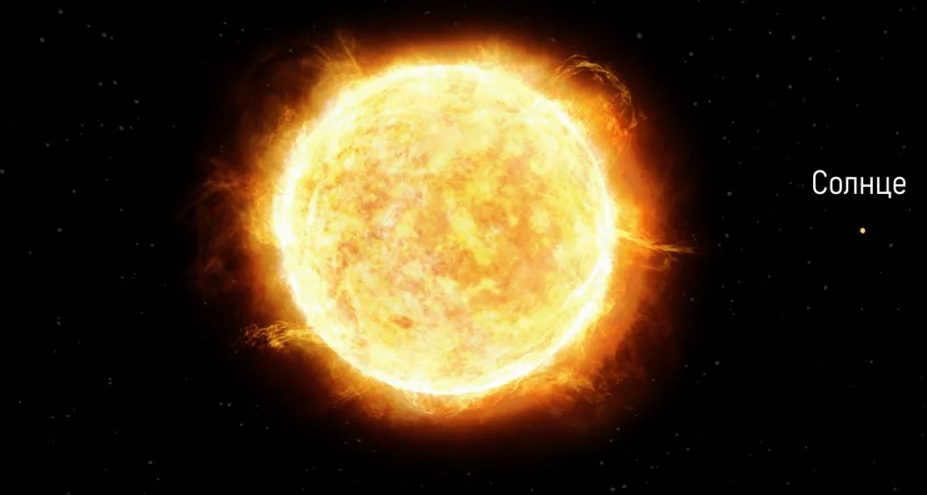
Furthermore, the Shield of UY pulsates, causing the luminary’s radius to occasionally extend to 1900 times the radius of the Sun. If this colossal star were positioned at the heart of our Solar System, it would engulf even Jupiter. The magnitude of this record-breaking star’s volume is so immense that it could accommodate 5 billion stars the size of our Sun.
Remarkably, the mass of UY Shield is merely 10 times that of the Sun. As a result, it possesses an incredibly low density. In fact, Earth’s atmosphere is nearly a million times denser than this hypergiant!
It is worth mentioning that due to stellar evolution laws, UY Shield, similar to other giants, is fated to meet its demise swiftly. In just a few million years, it will transform into a Wolf-Rayet star, triggering a tremendously powerful explosion commonly referred to as a supernova eruption. Consequently, only a minuscule neutron star will remain in the stead of the former colossal celestial body.
The largest star in the universe
As we have discovered, Shields’ UY is an immense yet relatively lightweight star. So, which celestial body possesses the highest mass? It is R136a1, situated in the Large Magellanic Cloud galaxy, around 165 thousand light-years away from our planet. The mass of this star surpasses that of the Sun by a staggering 315 times. Interestingly, the diameter of R136a1 is actually smaller than that of UY Shield by a factor of 50.
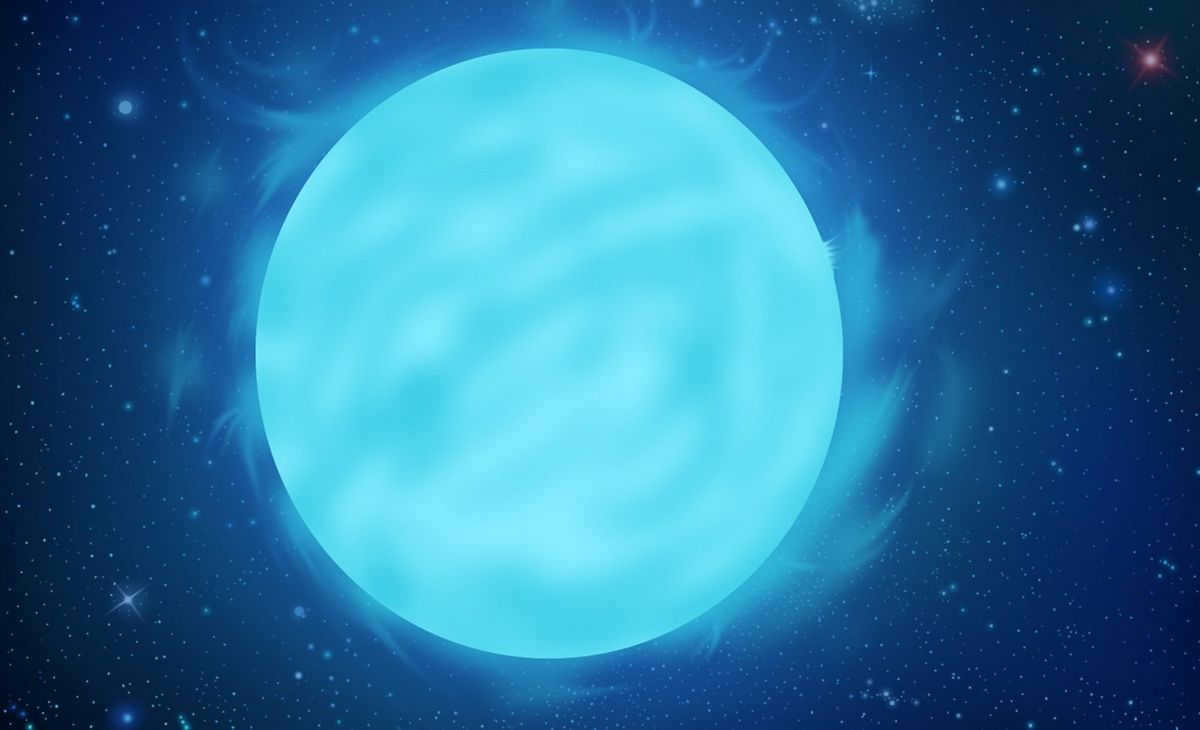
R136a1 holds numerous other records. It is currently the most luminous star in the known universe, emitting light that is 10 million times brighter than our Sun. With a surface temperature of 56,000 °C, it also holds the title for being the hottest star.
Interestingly, astrophysicists made a significant discovery in 1924 when they established an upper limit to the mass of stars. Today, calculations indicate that this limit is 150 times the mass of our Sun. Surprisingly, R136a1 exceeds this limit by more than 2 times, defying the laws of physics and raising questions among astronomers. This paradox still remains unexplained.
The most plausible explanation suggests that R136a1 was formed through the merger of multiple massive stars, each initially below the 150 solar mass limit.
There exists both an upper and a lower threshold for the mass of a star. The lower limit is approximately 0.075 solar masses. If a celestial object weighs less than this threshold, it will not have the necessary conditions for nuclear reactions to occur. Have astronomers been able to locate stars that come close to this theoretical limit?
In 2013, a star known as 2MASS J0523-1403 was discovered just 40 light years away. This red dwarf star has an estimated mass of 0.08 solar masses and a radius of less than 60,000 km. As a result, 2MASS J0523-1403 is smaller in size (but not mass) than even Jupiter and only slightly larger than Saturn.
The surface temperature of this mini-star is 2074 °K, making it the coldest star known to us. Its luminosity is nearly 8,000 times less than that of the Sun, which explains why we have only recently been able to detect a star in such close proximity to us.
Neutron Stars
Within the field of astronomy, there exist celestial objects known as neutron stars. Despite having a radius measuring a mere 10-20 km, the mass of these entities can surpass that of the Sun! Consequently, these bodies possess an extraordinary density, surpassing even that found within atoms.
Neutron stars exhibit a fascinating structure – their entire core, or nucleus, consists of densely packed neutrons, which are then enveloped by a crust composed of heavy element nuclei.
In simpler terms, the matter within neutron stars is compressed to such an extent that it merges into a solitary atom of incomprehensible magnitude. Additionally, the rotational velocity of neutron stars is equally astounding, as they can complete numerous revolutions along their axis within a single second.
The question arises – why is 2MASS J0523-1403 with a size of 60,000 km considered to be the tiniest star in the Universe, when the radius of neutron stars does not exceed 20 km? The reason is that a star is actually defined as a celestial body where thermonuclear reactions occur. In a neutron star, these reactions do not happen, so they are not genuine stars in the literal sense of the term.
Engaging information about stars:

🔸 In the solar system, there is only one star, but it is not uncommon to find double systems in the universe. In fact, double systems are more commonly observed than single systems. However, systems consisting of three or more stars are much rarer. The Castor system holds the record with its six stars!
🔸 On Earth, people are used to thinking of blue light as “cold” compared to red or yellow light. However, in astronomy, the situation is the opposite. Blue stars have the highest temperature, while red stars are considered the coldest. Additionally, there are brown dwarfs that resemble stars but are not classified as such.

